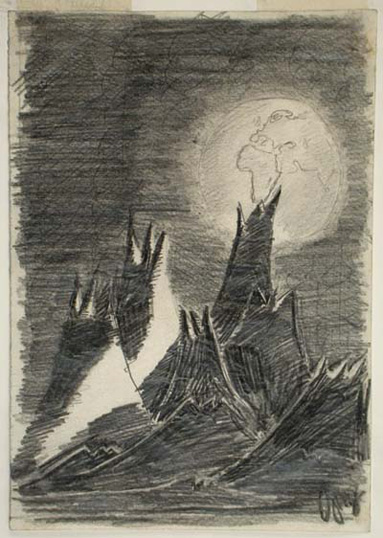
According to the Book of Revelation in the New Testament of the Christian Bible, Armageddon is the prophesied location of a gathering of armies for a battle during the end times, variously interpreted as either a literal or a symbolic location. The term is also used in a generic sense to refer to any end of the world scenario. In Islamic theology, the Armageddon is also mentioned in Hadith as the Greatest Armageddon or Al-Malhama Al-Kubra.

The Book of Lamentations is a collection of poetic laments for the destruction of Jerusalem in 586 BCE. In the Hebrew Bible it appears in the Ketuvim ("Writings"), beside the Song of Songs, Book of Ruth, Ecclesiastes and the Book of Esther, although there is no set order; in the Christian Old Testament it follows the Book of Jeremiah, as the prophet Jeremiah is its traditional author. Jeremiah's authorship is no longer generally accepted, although it is generally accepted that the destruction of Jerusalem by Babylon in 586 BC forms the background to the poems.
Christian eschatology is a major branch of study within Christian theology dealing with the "last things." Eschatology, from two Greek words meaning "last" (ἔσχατος) and "study" (-λογία), is the study of 'end things', whether the end of an individual life, the end of the age, the end of the world or the nature of the Kingdom of God. Broadly speaking, Christian eschatology is the study concerned with the ultimate destiny of the individual soul and the entire created order, based primarily upon biblical texts within the Old and New Testament.
Native Esperanto speakers are people who have acquired Esperanto as one of their native languages. As of 1996, there were 350 or so attested cases of families with native Esperanto speakers. Estimates from associations indicate that there were around 1,000 Esperanto-speaking families, involving perhaps 2,000 children in 2004. According to a 2019 synthesis of all the estimates made, they would be between several hundred and 2000, and would compose between <1% and 4.5% of the Esperanto community. In all known cases, speakers are natively bilingual, or multilingual, raised in both Esperanto and either the local national language or the native language of their parents. In all but a handful of cases, it was the father who used Esperanto with the child. In the majority of such families, the parents had the same native language, though in many the parents had different native languages, and only Esperanto in common.

The Palestinian people, also referred to as Palestinians or Palestinian Arabs, are an ethnonational group comprising the modern descendants of the peoples who have lived in Palestine continuously over the centuries and who today are largely culturally and linguistically Arab; this definition includes those ethnic Jews and Samaritans who fit this definition. Despite various wars and exoduses, roughly one half of the world's Palestinian population continues to reside in historic Palestine, the area encompassing the West Bank, the Gaza Strip and Israel. In this combined area, as of 2005, Palestinians constituted 49% of all inhabitants, encompassing the entire population of the Gaza Strip (1.865 million), the majority of the population of the West Bank and 20.95% of the population of Israel proper as Arab citizens of Israel. Many are Palestinian refugees or internally displaced Palestinians, including more than a million in the Gaza Strip, about 750,000 in the West Bank and about 250,000 in Israel proper. Of the Palestinian population who live abroad, known as the Palestinian diaspora, more than half are stateless, lacking citizenship in any country. Between 2.1 and 3.24 million of the diaspora population live as refugees in neighboring Jordan, over 1 million live between Syria and Lebanon and about 750,000 live in Saudi Arabia, with Chile's half a million representing the largest concentration outside the Middle East.
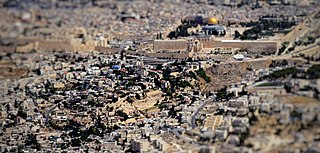
The City of David, called in Arabic: وادي حلوه, Wadi Hilweh, a neighborhood of Silwan, is a Palestinian Arab village intertwined with an Israeli settlement, and the archaeological site which is speculated to constitute the original settlement core of Bronze and Iron Age Jerusalem.

STS-107 was the 113th flight of the Space Shuttle program, and the 28th and final flight of Space Shuttle Columbia. The mission launched from Kennedy Space Center in Florida on January 16, 2003 and during its 15 days, 22 hours, 20 minutes, 32 seconds in orbit conducted a multitude of international scientific experiments.

Ilan Ramon was an Israeli fighter pilot and later the first and thus far only Israeli astronaut.

A landscape is the visible features of an area of land, its landforms, and how they integrate with natural or man-made features. A landscape includes the physical elements of geophysically defined landforms such as (ice-capped) mountains, hills, water bodies such as rivers, lakes, ponds and the sea, living elements of land cover including indigenous vegetation, human elements including different forms of land use, buildings, and structures, and transitory elements such as lighting and weather conditions. Combining both their physical origins and the cultural overlay of human presence, often created over millennia, landscapes reflect a living synthesis of people and place that is vital to local and national identity.

No man's land is land that is unoccupied or is under dispute between parties who leave it unoccupied due to fear or uncertainty. The term was originally used to define a contested territory or a dumping ground for refuse between fiefdoms. In modern times it is commonly associated with World War I to describe the area of land between two enemy trench systems, which neither side wished to cross nor seize due to fear of being attacked by the enemy in the process. The term is also used to refer to ambiguity, an anomalous, or indefinite area, in regards to an application, situation, or jurisdiction.
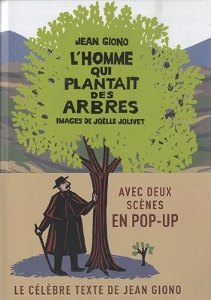
The Man Who Planted Trees is a short story published in 1953 by French author Jean Giono. An allegorical tale, it tells the story of one shepherd's long and successful single-handed effort to re-forest a desolate valley in the foothills of the Alps in Provence throughout the first half of the 20th century. It was written in French, but first published in English.

Landscape painting, also known as landscape art, is the depiction of landscapes in art—natural scenery such as mountains, valleys, trees, rivers, and forests, especially where the main subject is a wide view—with its elements arranged into a coherent composition. In other works, landscape backgrounds for figures can still form an important part of the work. Sky is almost always included in the view, and weather is often an element of the composition. Detailed landscapes as a distinct subject are not found in all artistic traditions, and develop when there is already a sophisticated tradition of representing other subjects.

Vedem was a Czech-language literary magazine that existed from 1942 to 1944 in the Terezín concentration camp, during the Holocaust. It was hand-produced by a group of boys living in the Home One barracks, among them editor-in-chief Petr Ginz and Hanuš Hachenburg. Altogether, some 800 pages of Vedem survived World War II.

Petr Ginz was a Czechoslovak boy of partial Jewish background who was deported to the Theresienstadt concentration camp during the Holocaust. He died at the age of sixteen when he was transferred to Auschwitz concentration camp and gassed to death upon arrival. His diary was posthumously published.
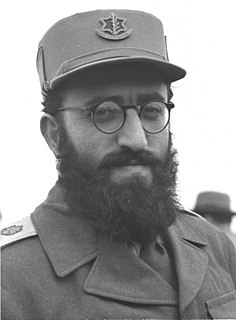
Shlomo Goren, was an Orthodox Religious Zionist rabbi in Israel, a Talmudic scholar and foremost authority on Jewish law (Halakha). He founded and served as the first head of the Military Rabbinate of the Israel Defense Forces and subsequently as the third Ashkenazi Chief Rabbi of Israel from 1973 to 1983, after which he established a yeshiva in Jerusalem, which he headed until his death.
American modernism, much like the modernism movement in general, is a trend of philosophical thought arising from the widespread changes in culture and society in the age of modernity. American modernism is an artistic and cultural movement in the United States beginning at the turn of the 20th century, with a core period between World War I and World War II. Like its European counterpart, American modernism stemmed from a rejection of Enlightenment thinking, seeking to better represent reality in a new, more industrialized world.

The Sangam Age was the period of history of ancient Tamil Nadu and Kerala and parts of Sri Lanka spanning from c. 6th century BCE to c. 3rd century CE. It was named after the famous Sangam academies of poets and scholars centered in the city of Madurai.
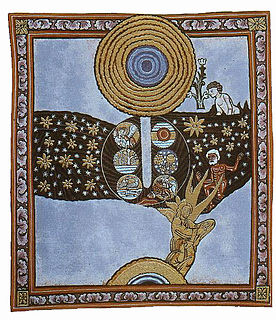
The term Hexameron refers either to the genre of theological treatise that describes God's work on the six days of creation or to the six days of creation themselves. Most often these theological works take the form of commentaries on Genesis. As a genre, hexameral literature was popular in the early church and medieval periods. The word derives its name from the Greek roots hexa-, meaning "six", and hemer-, meaning "day".
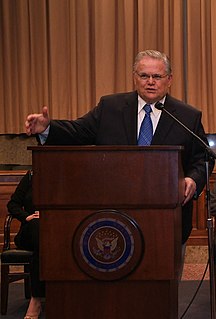
The blood moon prophecies are a series of prophecies in the Bible preached by Christian preachers John Hagee and Mark Biltz, which state that a tetrad which began with the April 2014 lunar eclipse is the beginning of the end times as described in the Bible in the Book of Joel, Acts 2:20, and Revelation 6:12. The tetrad ended with the lunar eclipse on September 27–28, 2015.
